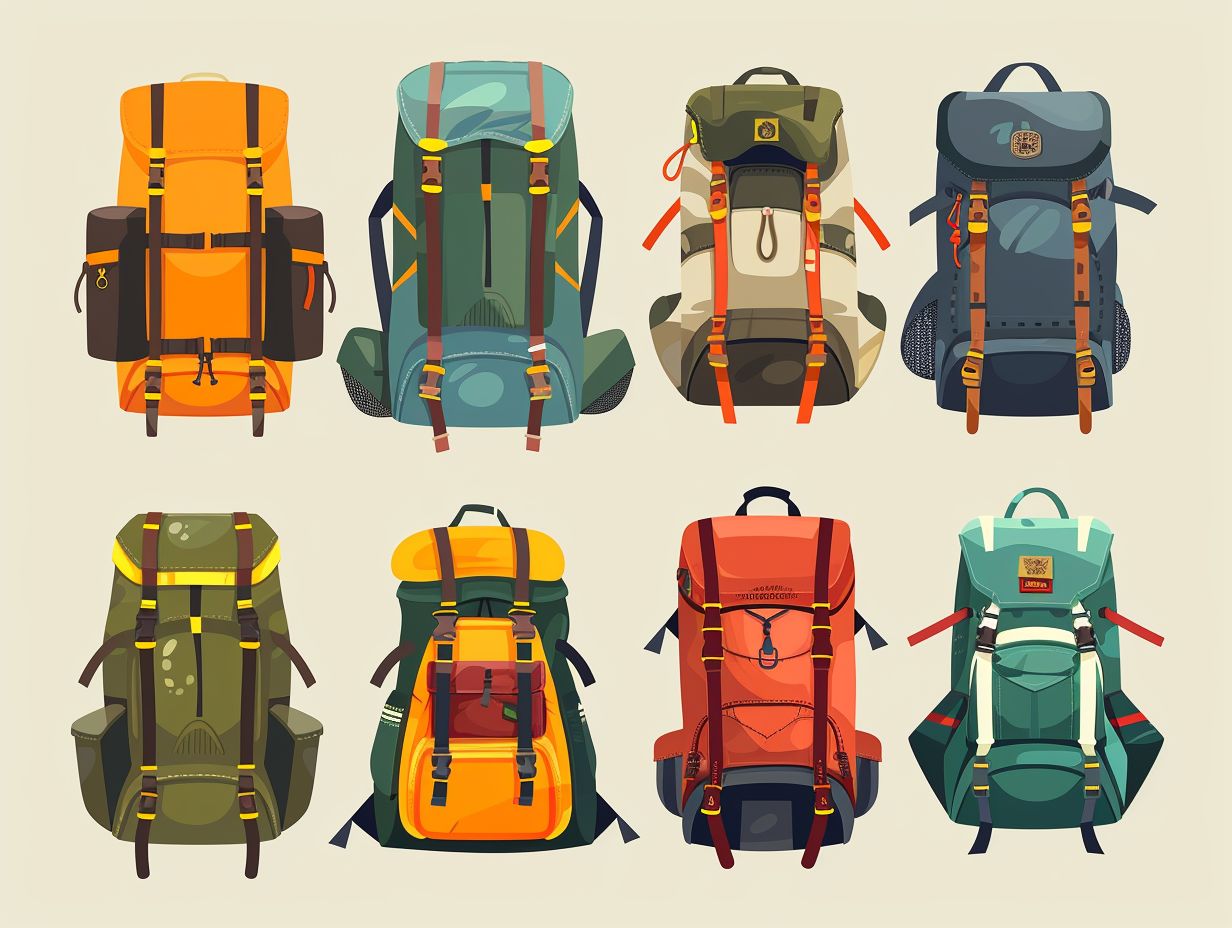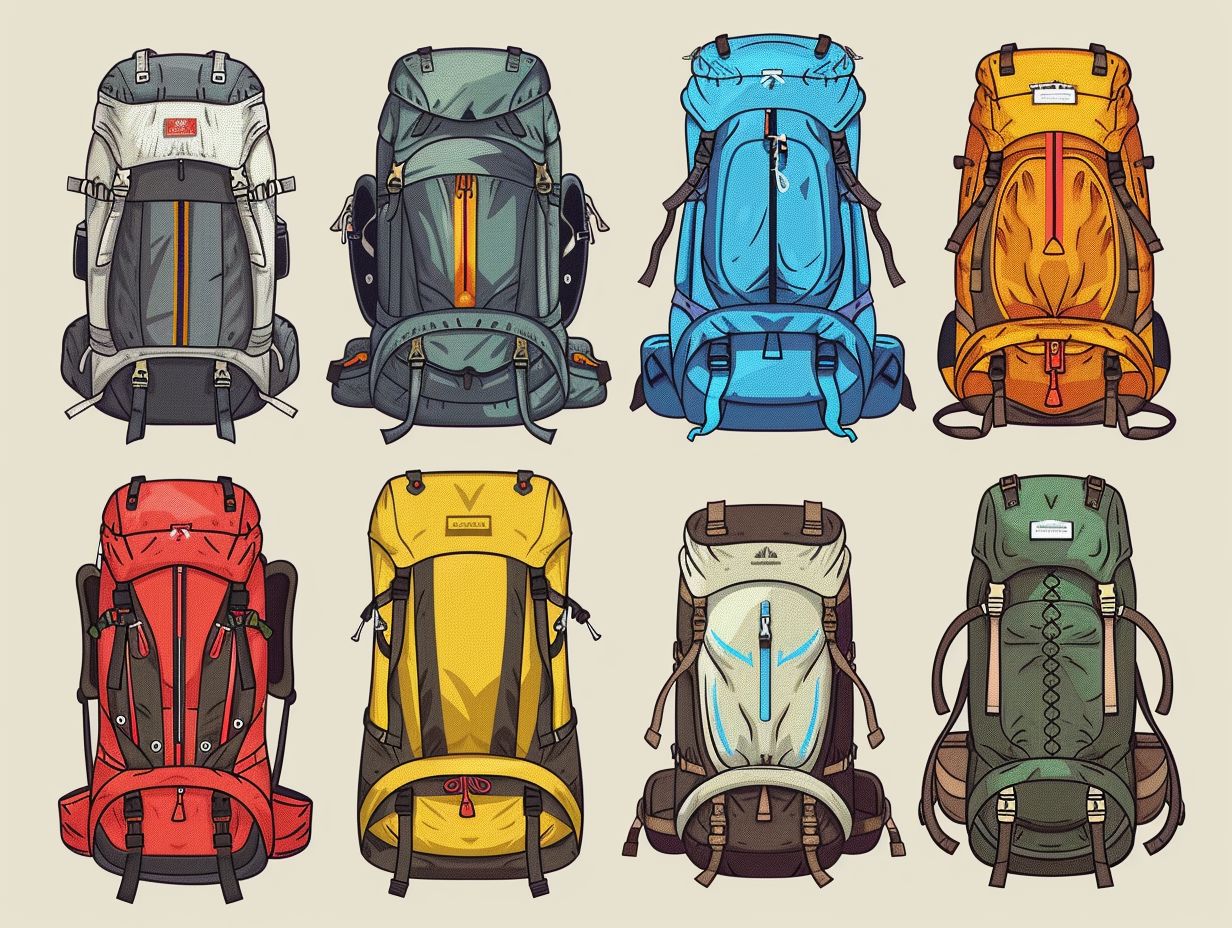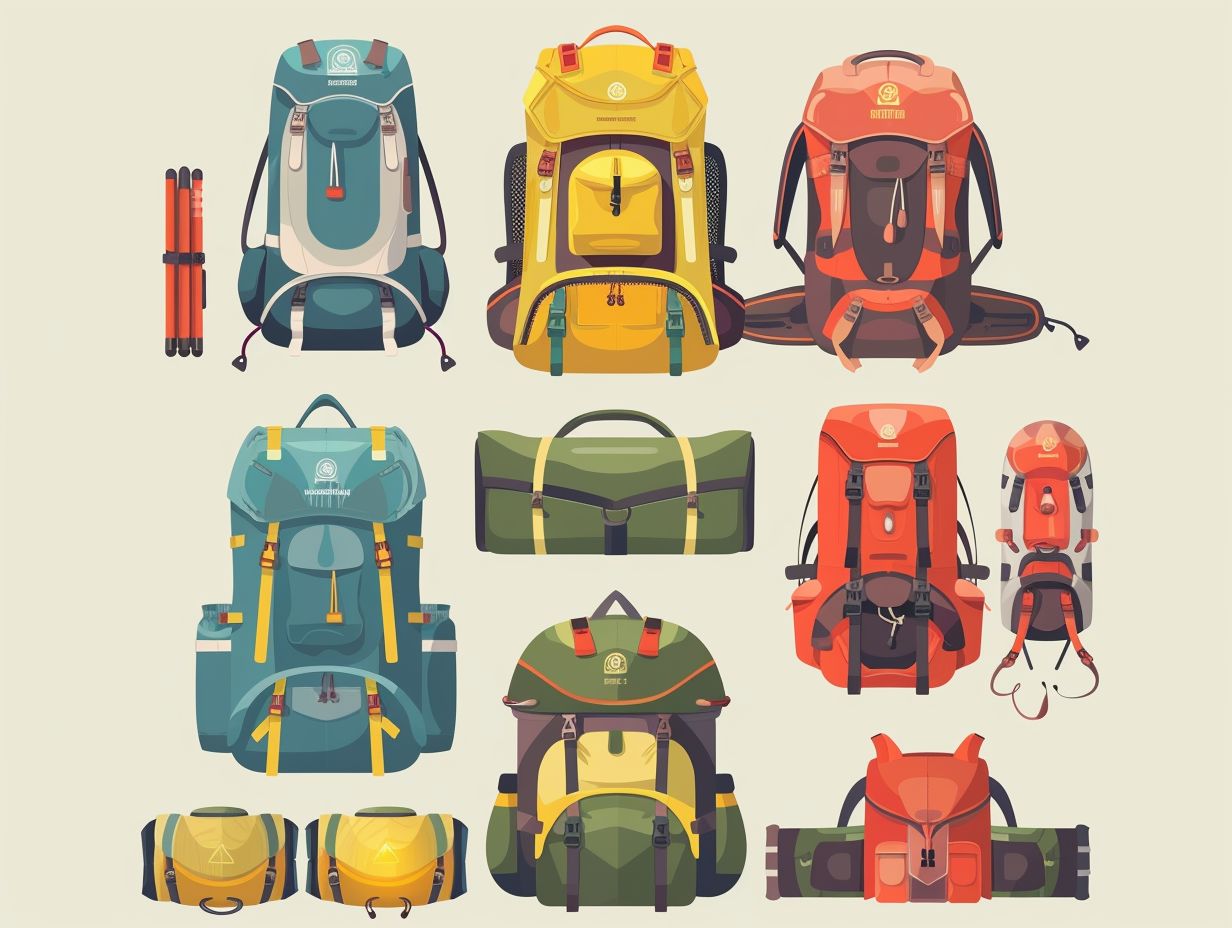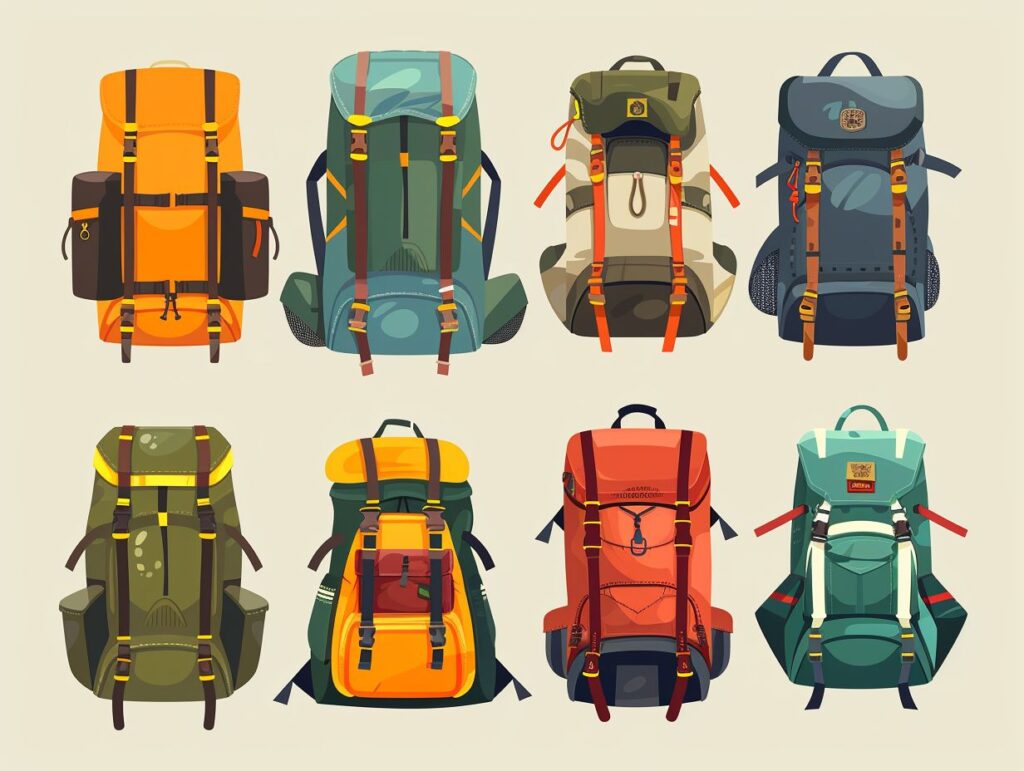Are you planning a hiking adventure but unsure about which backpack to choose?
We will explore the different types of hiking backpacks, key features to consider when selecting one, and tips for efficiently packing your gear.
Whether you are embarking on a day trip or a multi-day excursion, finding the right backpack can make all the difference in your outdoor experience.
Let’s make sure you are prepared for your next hiking journey!
Key Takeaways:

- Choose a hiking backpack based on the type of hike: day, overnight, weekend, or multi-day.
- Consider key features like size, fit, weight, organization, and suspension when choosing a hiking backpack.
- Pack your backpack evenly, keep essential items accessible, and use compartments and compression straps for efficiency and comfort on the hike.
Key Features to Look for in a Hiking Backpack

When selecting a hiking rucksack, it is imperative to consider several crucial features to ensure optimal comfort, proper fit, and alignment with the specific requirements of your hiking excursions.
1. Size and Capacity
The size and capacity of a hiking backpack play a crucial role as they dictate the amount of gear that can be carried and the pack’s suitability for various types of excursions.
When selecting the suitable volume for a hiking backpack, it is essential to take into consideration the duration and nature of the trips planned. For day hikes, a smaller backpack ranging from 20-30 litres may be adequate for carrying essentials such as water, snacks, a first aid kit, and extra clothing layers.
Overnight trips necessitate a larger pack with a volume of 30-50 litres to accommodate a sleeping bag, shelter, cooking supplies, and additional clothing. Extended multi-day expeditions require even larger packs in the range of 50-70 litres to store all necessary gear, including food, cooking equipment, and overnight camping essentials.
2. Fit and Comfort
Ensuring a proper fit and comfort are essential factors to consider when selecting a hiking rucksack. This involves adjustable torso length, well-padded shoulder straps, and a supportive hip belt to facilitate the even distribution of the load.
Accurate measurement of the torso length is crucial to ensure that the weight of the rucksack is appropriately distributed on the hips, thereby preventing strain on the shoulders and back.
The adjustment of shoulder straps enables a personalised fit, thereby reducing the likelihood of discomfort and chafing during extended hikes. Similarly, securing the hip belt firmly around the hips aids in stabilising the load, thus minimising excessive movement and fatigue.
These components work together to enhance overall comfort, enabling hikers to participate in their outdoor pursuits without enduring unnecessary discomfort or strain.
3. Weight and Durability
When selecting a hiking rucksack, it is crucial to consider factors such as weight and durability. Ultralight rucksacks are designed to offer comfort while maintaining strength and durability. These packs prioritize weight reduction, making them particularly suitable for long-distance hikers or individuals covering extensive terrain.
Although ultralight packs may trade off some durability compared to heavier alternatives, advancements in technology have led to the development of materials that are both lightweight and resilient enough to withstand the demands of hiking activities.
In the process of choosing a rucksack, it is important to strike a balance between weight and durability, aligning with the specific type of hiking one intends to undertake. Material selection plays a crucial role in this decision-making, with options such as ripstop nylon, Cordura, or Dyneema offering a suitable blend of lightweight properties and robustness.
By conducting a thorough assessment of personal requirements and the terrain to be traversed, individuals can make well-informed choices that guarantee both comfort and durability during their hiking endeavors.
4. Organisation and Accessibility
The organisation and accessibility of a hiking rucksack are crucial factors in efficiently managing gear. Well-designed pockets and compartments play a significant role in allowing easy access to essential items. The presence of multiple pockets and compartments within the rucksack is essential for maintaining organisation during hiking excursions.
Assigning specific spaces for each item, be it a water bottle, map, or snacks, enables easy retrieval without the need to sift through the entire pack. Moreover, incorporating easy-access features such as quick-access side pockets or front stash pockets offers convenient locations for retrieving items promptly while on the trail.
A meticulously planned rucksack design can significantly enhance the ease with which individuals navigate and enjoy their outdoor adventures.
5. Suspension and Ventilation
A well-designed suspension and ventilation system incorporated into a hiking rucksack serves to enhance comfort for the wearer. This enhancement is achieved by effectively distributing the load evenly across the wearer’s body and facilitating airflow to reduce perspiration.
Hiking rucksacks come equipped with various suspension systems, such as internal frame, external frame, and frameless designs, each offering distinct advantages depending on the terrain and load weight. Internal frame rucksacks are renowned for their stability and close fit to the wearer’s body, rendering them well-suited for demanding terrains.
In contrast, external frame rucksacks excel in weight distribution and ventilation, making them particularly suitable for carrying heavy loads in hot climates. Frameless rucksacks prioritize flexibility and reduced weight, making them ideal for shorter hiking excursions.
The integration of proper ventilation technology within these suspension systems plays a crucial role in preventing overheating and moisture accumulation. This feature ensures that hikers remain comfortable and dry throughout extended trekking adventures.
Tips for Packing Your Hiking Backpack

Efficiently packing your hiking rucksack is essential to maintain proper weight distribution, accessibility of essential items, and to enhance overall comfort during the hiking experience.
1. Distribute Weight Evenly
It is imperative to distribute weight evenly in the hiking backpack to maintain stability and comfort while trekking, thereby preventing any undue strain on the back and shoulders.
An effective strategy to achieve this equilibrium involves prioritising heavier items and positioning them nearest to your back and at the centre of the backpack. This method ensures a more uniform distribution of weight, consequently alleviating the strain on your body.
It is important to maintain a balanced load on both sides of the pack to avoid any uneven distribution, which could result in discomfort and potential injuries. Adhering to these guidelines will enhance the comfort and safety of your hiking experience.
2. Keep Essential Items Accessible
Ensuring that essential items are readily accessible in one’s hiking rucksack can prove to be a time-saving and efficient strategy, enabling individuals to retrieve necessary gear promptly without the need to unpack all contents. Effective organisation of items such as water bottles, snacks, maps, and first aid kits entails utilising the diverse pockets and compartments of the rucksack efficiently.
For instance, storing water bottles in side mesh pockets allows for convenient access to hydration, while keeping snacks in a front pocket facilitates quick energy replenishment. Placing maps in a waterproof compartment ensures easy reference, even in adverse weather conditions, and designating a specific location for the first aid kit enables swift access during emergencies.
By implementing strategic organisation techniques for gear, hikers can elevate their hiking experience and remain adequately equipped for any unforeseen circumstances.
3. Use Compartments and Compression Straps
Utilising the compartments and compression straps within one’s hiking rucksack can significantly improve organisation and stability, ensuring that the gear remains secure and balanced.
Compartments are essential for facilitating easy access to items such as snacks, water bottles, and first aid kits during the trek. Assigning specific gear to individual compartments enables expedited retrieval without the need to extensively search through the entire rucksack.
Conversely, compression straps serve a critical function in tightening the load and preventing items from shifting during movement. This action contributes to maintaining an equitably distributed weight, thereby alleviating strain on the body and enhancing overall comfort during extended hiking expeditions.
4. Pack Light and Efficiently
The efficient and minimalist packing of essential items is fundamental for a successful hiking experience. This approach involves focusing on necessary gear while eliminating unnecessary luxury items to reduce the overall weight of one’s rucksack.
In preparation for a hiking expedition, it is crucial to prioritise lightweight equipment that can serve multiple functions. Opting for an ultralight rucksack can significantly alleviate the strain on the back and shoulders, enabling hikers to traverse the trails without feeling encumbered.
When planning for a hike, it is advisable to consider factors such as weather conditions and terrain to ascertain the necessary items for the journey. Emphasising the importance of essentials over non-essential items, such as prioritising a reliable water filter over an extra set of clothing, is paramount.
By refining the packing list to include only essential items, hikers can not only reduce the burden of their load but also enhance their ability to navigate the trail efficiently.
Frequently Asked Questions
What factors should I consider when choosing a hiking backpack?

When choosing a hiking backpack, it is important to consider factors such as size, fit, weight, durability, and features. You should also think about the type of hiking you will be doing and the length of your trips.
What size backpack should I get for hiking?
The size of your hiking backpack will depend on the length of your trips and how much gear you need to bring. For day hikes, a 20-30 liter backpack may be sufficient, while for multi-day trips, a 50-70 liter backpack is recommended.
How do I ensure a proper fit for my hiking backpack?
To ensure a proper fit for your hiking backpack, make sure to try it on and adjust the straps before purchasing. The hip belt should sit comfortably on your hips and the shoulder straps should not dig into your shoulders. The weight should also be evenly distributed.
What materials are best for a hiking backpack?
Ideally, a hiking backpack should be made of lightweight and durable materials such as nylon, polyester, or ripstop fabric. These materials are water-resistant and can withstand the wear and tear of hiking.
Are there specific features I should look for in a hiking backpack?
Some important features to consider in a hiking backpack include multiple compartments for organization, a rain cover for protection against the elements, and a hydration bladder compatible design. You may also want to look for backpacks with adjustable suspension systems for added comfort.
How do I choose the right brand of hiking backpack?
When choosing a brand for your hiking backpack, it is important to do your research and read reviews from other hikers. Look for reputable brands known for their quality and durability, and consider factors such as warranty and customer service when making your decision.

